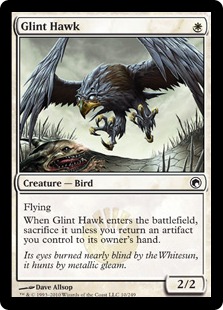This deck harkens back to when Scars of Mirrodin block was legal in Standard. Innistrad was the newest set, but it had yet to make a major impact on the metagame. Its derives its name from two of its most defining cards - Kuldotha Rebirth and Glint Hawk - which combined with Ichor Wellspring creates a synergistic mix of cheap creatures, artifacts, and burn spells. During Season 15 of Monday Pauper Deck Challenge, variations of this deck won nearly half of the tournaments, and was considered the deck to beat as the season drew to a close. So then, let's take a look at the decklist:
Kuldotha Hawk
| Creatures 4 Glint Hawk 4 Perilous Myr 2 Manic Vandal 10 cards Other Spells 4 Brimstone Volley 4 Flayer Husk 4 Galvanic Blast 4 Geistflame 4 Ichor Wellspring 4 Kuldotha Rebirth 4 Sylvok Lifestaff 3 Incinerate 1 Remember the Fallen 32 cards |
Lands 10 Mountain 5 Plains 3 Shimmering Grotto 18 cards
Sideboard
4 Nihil Spellbomb 4 Revoke Existence 3 Suture Priest 2 Silverchase Fox 2 Manic Vandal 15 cards |

|
At its heart, Kuldotha Hawk is an Aggro deck, relying upon cheap creatures and a swath of burn spells to destroy an opponent before he or she can stabilize. It heavily emphasized spells, running 12 or fewer actual creatures in the main deck (of course, both Kuldotha Rebirth and Flayer Husk should be considered creature spells as well). These creatures were further augmented with Equipment in the form of Sylvok Lifestaff and Flayer Husk. These equipment also contribute to the total of 24 or more Artifact spells, allowing the deck to easily achieve Metalcraft, which this particular variant only utilizes for Galvanic Blast. Finally, burn spells such as Geistflame, Incinerate, the aforementioned Galvanic Blast, and Brimstone Volley made for a potent suite of burn spells, often serving as a powerful finisher for the deck. Finally, by utilizing the bounce "drawback" of Glint Hawk, the deck was capable of drawing a surprisingly high number of cards.
Summarizing then, here are the elements that made this deck so successful:
- It was blazing-fast, using cheap creatures and burn spells to quickly finish off an opponent.
- It used equipment to buff its smaller creatures for maximum value.
- It was capable of drawing lots of cards.
- Its low mana curve and card drawing engine allowed it to run very few lands.
No comments:
Post a Comment